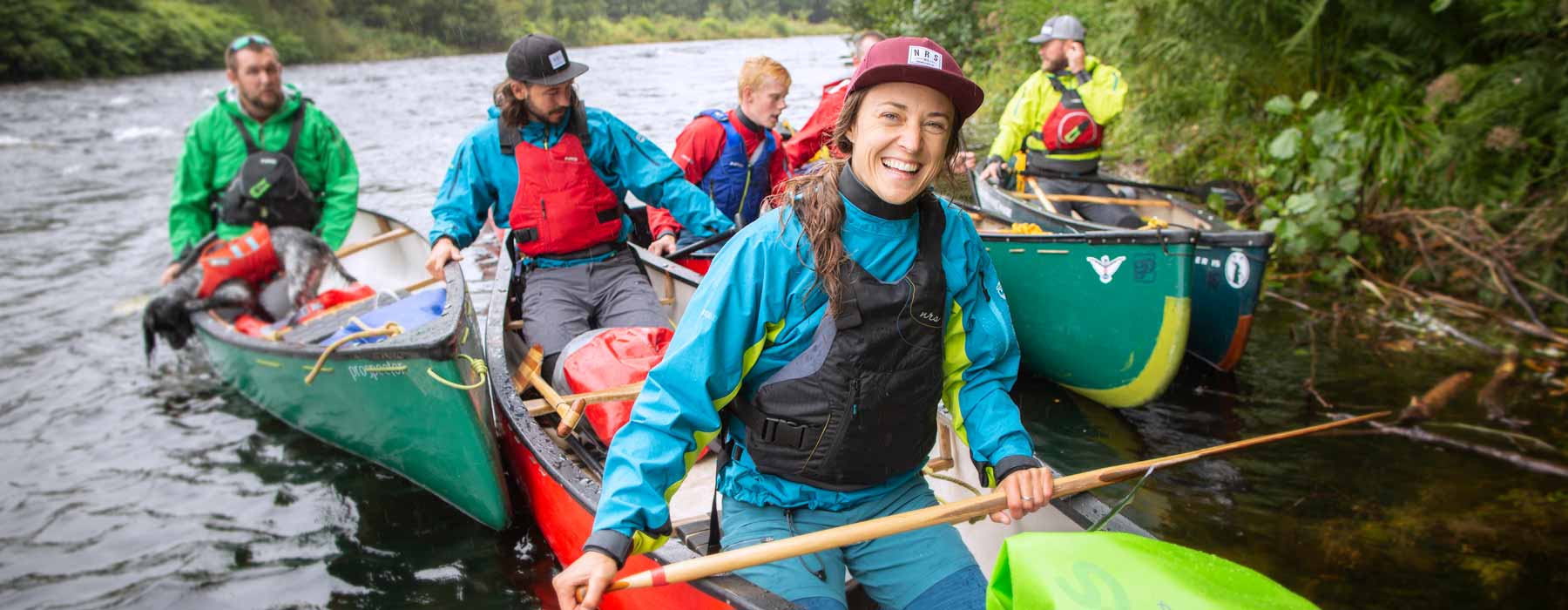
ABCs of PFDs
There’s a Reason They Call Them “Life Jackets”
We’re often asked, “What’s the best life jacket?” The best answer we can give is, “The one you’re wearing when you need it.” And you’re much more likely to be wearing it if it fits well and is comfortable enough to wear all day while you’re on the water. We carry a wide array of models to ensure there’s a good fit for all body types and builds.
Even if you’re a good swimmer, a life jacket (often referred to as a PFD, for Personal Flotation Device) gives you that extra margin of safety while boating. Especially in aerated whitewater or when the water is cold, a properly chosen and fitted PFD can literally be the difference between life and death.
Most adults in a bathing suit need seven to 12 pounds of extra flotation to keep their head out of the water. The US Coast Guard specifies a minimum of 15 1/2 pounds flotation in an adult PFD. If you’re a swimmer and comfortable in the water, a jacket with 16–18 pounds of design flotation should be fine for you. If you’re a non-swimmer, you may feel more secure in a higher flotation model, one in the 22–27 pound range. The more muscle you have, the more flotation you need.
The more flotation in a jacket, the higher you float and the faster you pop to the surface. However, that additional flotation makes the jacket bulkier and possibly less comfortable. Again, finding a PFD you’re comfortable in is the most important criteria. All our jackets exceed the Coast Guard flotation minimum. The highest flotation jacket in the world won’t do you any good if you’re not wearing it when it’s needed!
Choosing Your Life Jacket
In addition to flotation, here are a few things to look for when choosing your PFD:
- Multiple adjustment points help in customizing the fit to your body. Start with the lowest adjustment point, generally at the waist, and then work up the jacket tightening them in turn, the shoulder straps last. It needs to fit snugly, so it doesn’t slip over your head when you enter the water.
- Large armholes allow for active movement in rowing and paddling.
- Lash tabs and other attachment points for securing a knife, strobe or other accessory to the outside of the jacket.
- Pockets for stowing articles you want easy access to.
- Reflective tape or piping on touring jackets to make you more visible to motorized craft.
- If you have a kayak seat back that interferes with your PFD, look for a model with reduced foam thickness or mesh in the lower back of the jacket.
- Bright colors make you more visible.
Children’s bodies are tricky to fit with a PFD; to work right it must fit snugly. To check for a good fit, carefully pick the child up by the shoulders of the PFD. If the PFD fits right, the child’s chin and ears will not slip through. A jacket with leg straps helps prevent ride-up, giving an extra measure of safety.
So, get a good fitting PFD and wear it while you’re on the water. If you have questions, reach out to our friendly customer service department.
Coast Guard Approval Ratings:
Type I
Provides the most buoyancy. It is effective for all waters, especially open, rough or remote waters where rescue may be delayed. It is designed to turn most unconscious wearers in the water to a face-up position.
Type II
Intended for calm, inland water or where there is a good chance of quick rescue. Inherent buoyant PFDs of this type will turn some unconscious wearers to a face-up position in the water, but the turning is not as pronounced as a Type I. This type of inflatable turns as well as a Type I foam PFD.
Type III
Good for conscious users in calm, inland water, or where there is a good chance of quick rescue. It is designed so wearers can place themselves in a face-up position in the water. The wearer may have to tilt their head back to avoid turning face-down in the water. The Type III foam vest has the same minimum buoyancy as a Type II PFD. It comes in many styles, colors, and sizes and is generally the most comfortable type for continuous wear. Float coats, fishing vests, and vests designed with features suitable for various sports activities are examples of this type PFD. This type inflatable turns as well as a Type II foam PFD.
Type IV
Intended for calm, inland water with heavy boat traffic, where help is always present. It is designed to be thrown to a person in the water and grasped and held by the user until rescued, it is not designed to be worn. Type IV devices include buoyant cushions, ring buoys, and horseshoe buoys. There are no inflatable Type IV devices.
Type V
Intended for specific activities and may be carried instead of another PFD only if used according to the approval condition(s) on its label. A Type V PFD provides performance of either a Type I, II, or III PFD (as marked on its label). If the label says the PFD is “approved only when worn” the PFD must be worn, except for persons in enclosed spaces and used in accordance with the approval label, to meet carriage requirements. Some Type V devices provide significant hypothermia protection. Varieties include deck suits, work vests, and board sailing vests.
Type III/V
Multi-purpose commercial vests.